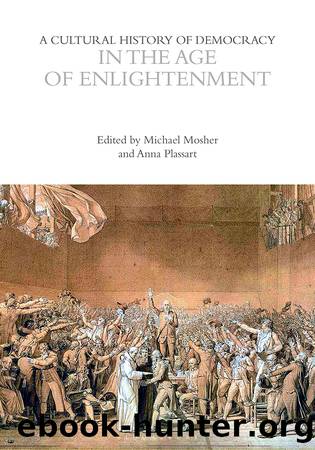A Cultural History of Democracy in the Age of Enlightenment by Michael Mosher;Anna Plassart;

Author:Michael Mosher;Anna Plassart;
Language: eng
Format: epub, pdf
Publisher: Bloomsbury UK
FIGURE 6.1 Jacques-Louis David, The Lictors Bring to Brutus the Bodies of His Sons, 1789. Davidâs immediately prerevolutionary painting captures the divide between male and female stereotypes to come. Photograph by Leemage/Corbis via Getty Images.
CITIZENS
So what did it mean for Mary Wollstonecraft repeatedly to demand that women should be treated like âcitizensâ? One answer to this question might be the revolutionâs own attempt to define citizenship, the famous document known as the Declaration of the Rights of Man and of the Citizen of August 26, 1789. This was conceived as the preamble to the new constitution that the deputies of the Third Estate had committed themselves to bring into being by the famous Tennis Court Oath of June 17, 1789. In between those two events had come the night of August 4, 1789, which had seen the Constituent Assembly destroy the regime of feudal privilege on which the Old Regime monarchy was based. Now that privilege was no longer in place, it could be replaced by rights. Rights had been debated all the way through the eighteenth century, starting with Locke and ending with the idea that human beings (âManâ) were loci for rights simply from the fact of being rational human creatures (Tuck 1992).
Unlike privileges, which could potentially be removed by whatever power had granted them, rights were innate. Ideas about rights thus tended to accompany the glorification of individual autonomy, very similar to the self-reliance and self-containment included in the Stoic ideal. They also tended to be accompanied by a wish for popular sovereignty (whatever was meant by popular), and for government as a contract between ruler and ruled, rather than a divinely sanctioned order. Diderot, for example, advising the Empress Catherine of Russia on her own project for a constitution in the 1770s, had roundly stated that the people should be sovereign: âThere is no true sovereign except the nation; there can be no true legislator except the peopleâ (Diderot [1774] 2004). These âObservations,â which Diderot began to write in 1774, were unwelcome to Catherine and were not published until 1920. (They may well have circulated in manuscript beforehand.) But Diderot never really defined the rights that should be held. In this, he was not unlike other Enlightenment thinkers. As Lynn Hunt has pointed out, even Rousseau ânever precisely defined rights beyond the right of all men to participate in making the social contractâ (Hunt 1996: 6). Locke defined it as the right under the law to âpreserve his property, that is, his life, liberty and estate, against the injuries and attempts of other menâ (Locke [1689] 1963: 366â7). Diderot also linked the sovereignty of the people with equality before the laws, as the French revolutionaries were to do (Diderot [1774] 2004: para. 20). Diderot, in his controversial article âAutorité politiqueâ (âPolitical Authorityâ) in the Encyclopédie, had squarely stated, âNo man has by nature been granted the right to command others. Liberty is a gift from heaven, and every member of the same species has the right to enjoy it as soon as he is in possession of reasonâ (Darnton 1987).
Download
A Cultural History of Democracy in the Age of Enlightenment by Michael Mosher;Anna Plassart;.pdf
This site does not store any files on its server. We only index and link to content provided by other sites. Please contact the content providers to delete copyright contents if any and email us, we'll remove relevant links or contents immediately.
Spell It Out by David Crystal(35861)
Life for Me Ain't Been No Crystal Stair by Susan Sheehan(35550)
Cecilia; Or, Memoirs of an Heiress — Volume 1 by Fanny Burney(32093)
Cecilia; Or, Memoirs of an Heiress — Volume 3 by Fanny Burney(31481)
Cecilia; Or, Memoirs of an Heiress — Volume 2 by Fanny Burney(31435)
The Great Music City by Andrea Baker(30931)
Professional Troublemaker by Luvvie Ajayi Jones(29445)
We're Going to Need More Wine by Gabrielle Union(18664)
Twilight of the Idols With the Antichrist and Ecce Homo by Friedrich Nietzsche(18324)
The Secret History by Donna Tartt(18267)
All the Missing Girls by Megan Miranda(14857)
Cat's cradle by Kurt Vonnegut(14804)
Pimp by Iceberg Slim(13828)
Bombshells: Glamour Girls of a Lifetime by Sullivan Steve(13718)
Fifty Shades Freed by E L James(12937)
Talking to Strangers by Malcolm Gladwell(12916)
Norse Mythology by Gaiman Neil(12880)
The Social Justice Warrior Handbook by Lisa De Pasquale(11969)
Underground: A Human History of the Worlds Beneath Our Feet by Will Hunt(11857)
